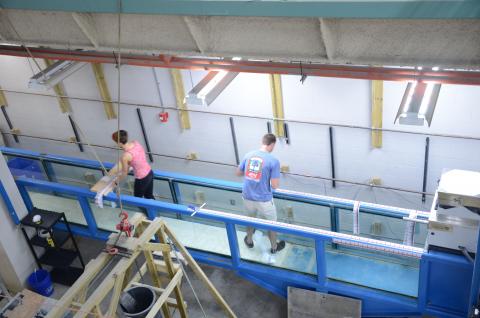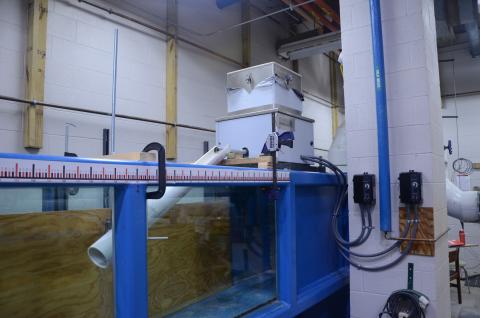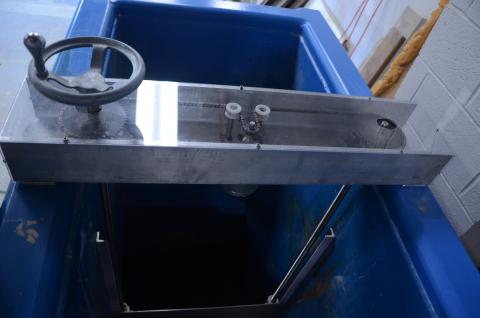Table of Contents
1 Location:
Hydraulics Laboratory, Department of Civil and Environmental Engineering
School of Engineering and Computing
University of South Carolina
300 Main St
Columbia SC 20208
2 Specifications
2.1 Dimensions
- Length: 42.5 ft
- Width: 20 inches
- Depth: 2 ft
2.2 Structure
- Frame: Steel
- Walls: Glass
2.3 Features
2.3.1 Hydraulic tilting jacks
Two hydraulic jacks are able to lift the flume at the upstream supports while it pivots about the downstream supports.
2.3.2 Tail gate downstream control
The downstream water elevation is controlled via a screw-operated aluminum sharp-crested weir. Current operation is manual. The gate has an integrated stepper motor to allow for future automation of its operation.
2.3.3 Sediment feeder
Sediment is supplied via a Schenk Accurate 600 feeder at the upstream end of the flume.
2.4 Water
2.4.1 Supply
A constant head tank supplies water to the flume via a 6-inch or an 8-inch supply line. Maximum flowrate is limited by the head tank capacity. Flowrate ranges between 0 and 50 lps.
2.4.2 Discharge
Water is discharged back into the mail sump of the laboratory, at the outstream end of the flume via a 12-inch PVC pipe controlled by a butterfly valve. A 4-inch corrugated hose is also available for slower drainage rates.
Water is also discharged through the sediment trap whenever the sediment trap gate valve is open.
All discharges outflow into the main laboratory sump.
2.5 Sediment
2.5.1 Supply
Sediment is supplied via Schenk Accurate 600 feeder located at the upstream end of the flume.
2.5.2 Extraction
Sediment is extracted from the flume via a sediment trap located at x-coordinate 890 cm from the upstream end of the flume. The 4-inch sediment-trap discharge pipe outflows into a larger sediment trap, where water and sediment are separated before allowing the water to outflow back into the main laboratory sump.
3 Current experiments
The flume is currently being used as part of the experimental setup for the NSF project The internal structure of deposits emplaced under upper plane bed / sheet flow transport conditions: Laboratory experiments and numerical modeling. (January 2013–December 2016).


